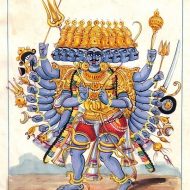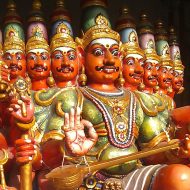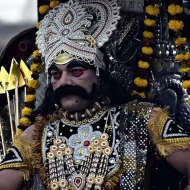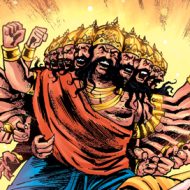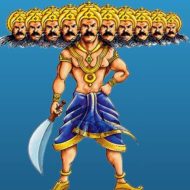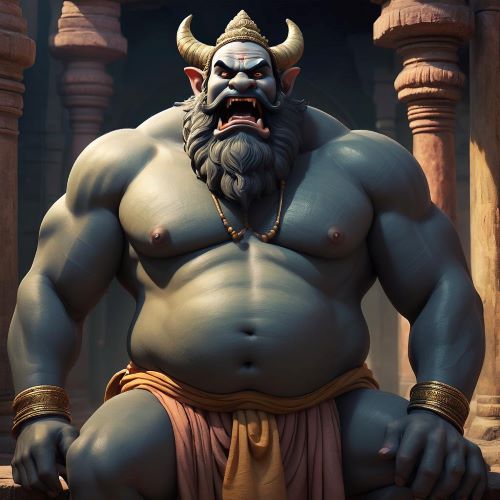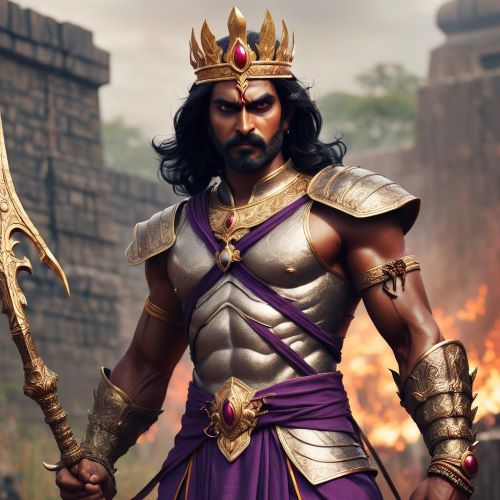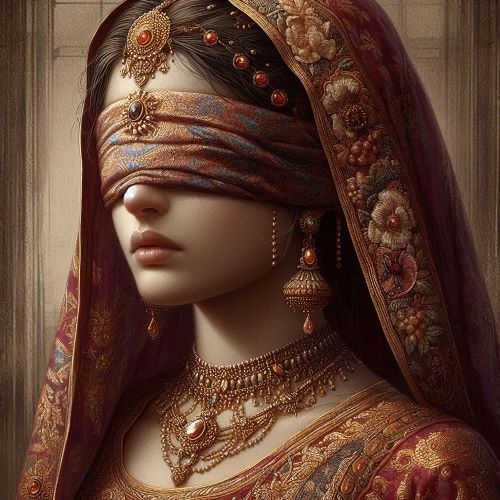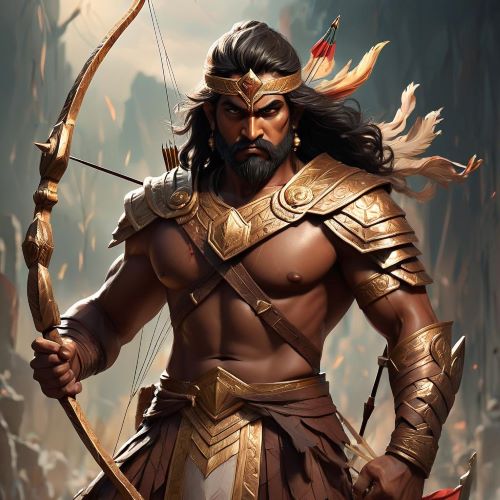Ravana : The Demon King
Listen
At a glance
| Description | |
|---|---|
| Origin | Indian Mythology |
| Classification | Mortals |
| Family Members | Vishrava (Father), Kaikasi (Mother), Kumbhakarna, Vibheeshana, Kubera (Brothers), Shoorpanaka (Sister), Indrajith (Son) |
| Region | India, Nepal, Sri Lanka, Cambodia, Indonesia, Vietnam |
| Associated With | Knowledge, Wealth |
Ravana
Introduction
Ravana, a pivotal figure in the Indian epic Ramayana, is commonly portrayed as the epitome of evil, primarily due to his role in the abduction of Sita, the wife of Lord Rama. However, his character is far from one-dimensional, encompassing a rich tapestry of complexity that combines both scholarly and warrior-like attributes. While he is simultaneously revered for his intelligence, strength, and devotion, his infamy stems from his arrogance and eventual downfall.
In the ancient Indian epic, Ravana emerges as a multifaceted character, serving as the ultimate antagonist who orchestrated the abduction of Rama’s beloved Sita, thereby triggering a cosmic war that reverberated across the realms. Yet, reducing Ravana to a mere embodiment of evil oversimplifies his character. Instead, he exists as a paradox, a being intricately woven from threads of brilliance and brutality, knowledge and arrogance, devotion and deceit.
Physical Traits
Ravana’s physical presence commands both awe and terror, as vividly depicted in the Ramayana. Described as a colossal giant with ten heads and twenty arms, his formidable stature is matched by eyes the color of burning coals. His massive frame, gleaming with a dark metallic hue, is adorned with resplendent jewelry and draped in animal skins, creating a fearsome visage. Each of his ten heads dons a golden crown, symbolizing his dominion over diverse realms, while a range of fearsome weapons, including his signature ten-headed mace, the gada, and the bow Chandrahasa, further accentuate his martial prowess.
Ravana’s fearsome form encapsulates raw power and unbridled ambition, instilling fear even in the bravest warriors. The ten heads and twenty arms are symbolic representations of his immense knowledge and strength, showcasing a multifaceted personality. Beyond the intimidating exterior, Ravana’s formidable stature and fierce demeanor serve as emblems of his indomitable spirit and martial prowess. Despite his imposing appearance, he transcends the stereotype of a mere brute, blending physical strength with a sharp intellect that makes him a truly formidable adversary.
Family
Ravana’s parentage traces back to the sage Vishrava and his wife, the daitya princess Kaikesi. In addition to his demonic lineage, Ravana’s unique heritage included divine roots, as he was the great-grandson of Lord Brahma, a prominent figure in the Hindu trinity responsible for creation. This dual nature placed Ravana at a crucial juncture, straddling the realms of light and darkness, possibly contributing to the intricate nature of his worldview.
Within his family, Ravana had six brothers and two sisters, among them the formidable Kumbhakarna and the virtuous Vibhishana. Despite their divine connections, the family dynamic was marked by tension and rivalry, mirroring the internal struggle within Ravana between the forces of good and evil. Noteworthy among his siblings were Kubera, the righteous god of wealth, and Vibhishana, who eventually aligned himself with Lord Rama. The complex relationships within Ravana’s family reflect the ongoing internal conflict and quest for dominance between opposing forces within his character.
Other names
Ravana is recognized by various alternate names, each shedding light on different facets of his character. Referred to as ‘Dashanana,’ this name underscores his ten heads, symbolizing his formidable intelligence. ‘Lankeshwar,’ translating to the Lord of Lanka, highlights his sovereignty over the kingdom he ruled. Other epithets include ‘Lankapati’ (Lord of Lanka), ‘Ravibhushana’ (one who delights in the sun), ‘Ravula,’ ‘Lankeshvara’ (lord of Lanka), and ‘Ravaneshwara’ (lord of the demons). These diverse names collectively accentuate his monstrous form, regal power, and insatiable thirst for knowledge, showcasing the multifaceted roles he played in the epic narrative.
Powers and Abilities
Ravana stood as a formidable warrior, a scholar well-versed in the Vedas, and a capable ruler. His prowess extended beyond mere physical strength, for he was a devout devotee of Lord Shiva and had received numerous boons from the powerful deity. These boons bestowed upon him invulnerability against gods, demons, and spirits, elevating Ravana to a position of unparalleled strength.
However, Ravana’s exceptional abilities were not confined to his warrior skills; he possessed a repertoire of supernatural powers. The ability to shapeshift, fly, vanish at will, and create illusions showcased his mastery over mysticism. His profound knowledge of the Vedas and sacred texts granted him expertise in both magic and weaponry. In a testament to his unparalleled strength, Ravana even dared to challenge and came close to subduing Shiva, the formidable god of destruction.
Ravana’s distinctive power set him apart, rendering him a formidable adversary and a force to be reckoned with in the cosmic narrative. Adding to his formidable arsenal was a potent weapon, the Shiva Dhanush (Shiva’s bow), a manifestation of his unwavering devotion to Lord Shiva. With this combination of martial skills, magical prowess, and divine blessings, Ravana’s character emerged as a complex and formidable figure in the tapestry of Indian mythology.
Modern Day Influence
Despite his role as an antagonist, Ravana’s impact on Indian culture is profound and far-reaching. He frequently finds resonance in classical Indian dance forms, theatre, and literature, serving as a symbolic representation of arrogance and power. In India, his demise, symbolizing the triumph of good over evil, is commemorated during the Dussehra festival. Ravana is not merely portrayed as a villain in various artistic mediums but is also depicted as a multifaceted and tragic figure, exploring the nuances of his character.
Ravana’s brilliance, unwavering devotion, and eventual tragic downfall resonate deeply with audiences, sparking debates about the complexities of good and evil and the blurry boundaries that separate them. During the Dussehra festival, effigies of Ravana are set ablaze, symbolizing the victory of good over evil. However, even in this act of destruction, a certain degree of grudging respect for Ravana’s character is often acknowledged.
In the realm of popular culture, Ravana continues to captivate audiences through diverse forms of media. Films, television series, and theatrical productions frequently portray him as a charismatic and powerful figure, emphasizing the inherent duality within his nature. His character becomes a metaphor for the internal conflicts experienced by individuals, highlighting the perpetual struggle between good and evil within each person.
Ravana’s influence extends beyond the artistic realm, seeping into political and philosophical discussions. Some political leaders and thinkers draw parallels between Ravana’s governance of Lanka and contemporary political scenarios, delving into themes of power, leadership, and morality. Philosophically, Ravana’s character prompts discussions about the nature of dharma (righteousness) and the intricate complexities of morality, challenging simplistic notions of good and evil.
Related Images
Frequently Asked Questions
What is lorem Ipsum?
I am text block. Click edit button to change this text. Lorem ipsum dolor sit amet, consectetur adipiscing elit. Ut elit tellus, luctus nec ullamcorper mattis, pulvinar dapibus leo.
What is lorem Ipsum?
I am text block. Click edit button to change this text. Lorem ipsum dolor sit amet, consectetur adipiscing elit. Ut elit tellus, luctus nec ullamcorper mattis, pulvinar dapibus leo.
What is lorem Ipsum?
I am text block. Click edit button to change this text. Lorem ipsum dolor sit amet, consectetur adipiscing elit. Ut elit tellus, luctus nec ullamcorper mattis, pulvinar dapibus leo.
What is lorem Ipsum?
I am text block. Click edit button to change this text. Lorem ipsum dolor sit amet, consectetur adipiscing elit. Ut elit tellus, luctus nec ullamcorper mattis, pulvinar dapibus leo.
What is lorem Ipsum?
I am text block. Click edit button to change this text. Lorem ipsum dolor sit amet, consectetur adipiscing elit. Ut elit tellus, luctus nec ullamcorper mattis, pulvinar dapibus leo.

